Denman Island is Home to at least 9 Bat Species
The big bats
Big Brown Bat
Eptesicus fuscus
One of the larger bats.
Wingspan 21-39cm. Wt 9-22g.
Large broad head. Moderate-sized ears but only reach to nose.
Pale to dark brown oily fur. Black ears and wing membrane.
Forearm >4.2cm, distinguishes from “little bat” myotis group.
Lifespan recorded up to at least 19 years in wild.
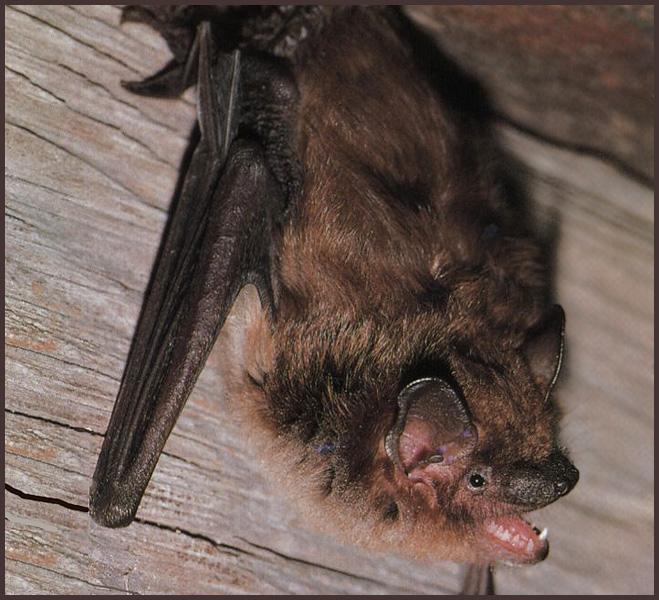
Habitat
Variety of habitats, favours buidings, seeks somewhat cooler roosts than myotis. Maternal colonies under tree bark, tree cavities and in buildings.
Food
Eats variety of insects, esp. small beetles. Relatively fast flyer.
Migration
Migration usually short distances to hibernate in BC & may be active in winter. May use buildings year round. Rarely found caves or mines in BC.
Range
Range: northern Canada to southern Mexico.
Horay Bat
Lasiurus cinereus
Largest BC bat.
Wingspan 34-42cm. Wt 20-38g.
Edges of ears rounded & black, yellow hair inside.
Distinctive grizzled colour: Back fur is dark brown & grey tinged with white. Patches of yellow or white on shoulders, throat, ear & undersides.Upper tail membrane furred.
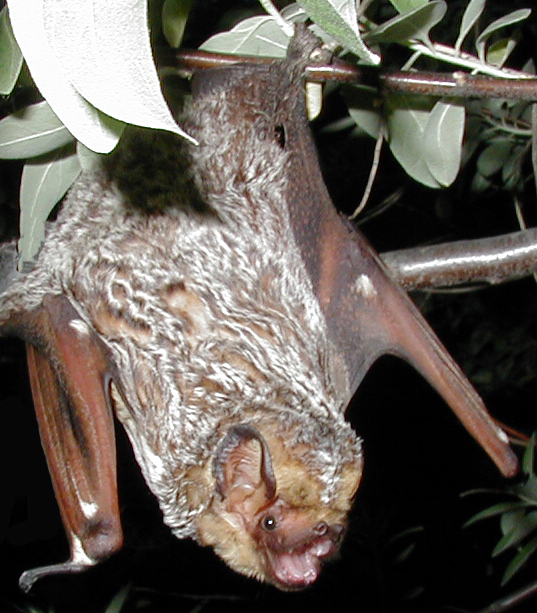
Colonies
Maternal colonies up to several hundred. In summer males roost alone.
Pup
One pup/year.
Migration
Highly agile in flight. Able to glean insects off vegetation.
Range
Hibernates in caves in the BC, incl. Vancouver Island.Range: Canada – only in BC. USA – mostly in west, in east rare.
The Medium-sized bats
Silver-haired Bat
Lasionycteris noctivagans
‘hairy wandering night’
Medium-sized. Wingspan 27-35cm. Wt 6-12 g.
Ears short, round.
Dark brown or black fur tipped with white.
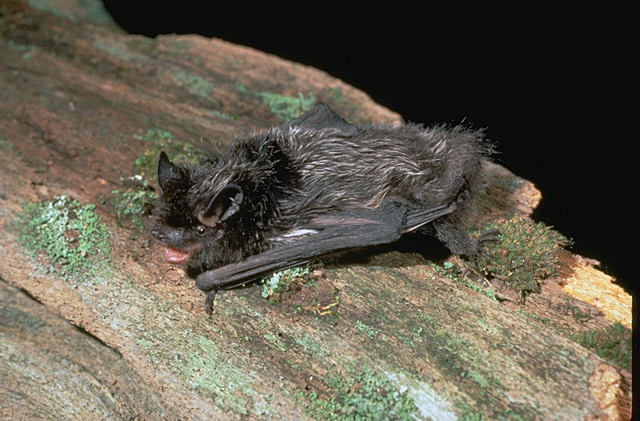
Habitat
Often roosts alone or small groups. Forest-dwelling, often in tree cavities. Rarely in buildings except temporarily during migration. Maternal colonies small.
Pups
Usually 2 pups/year.
Food
Eat moths, beetles & emerging aquatic larvae usually caught over water, while avoiding competition with big brown & hoary bats. Slow erratic flight, may be near ground.
Range
Across NA – NE Mexico to SE Alaska. BC populations may not migrate, but other populations go south to USA.
Townsend’s Big-eared Bat
Corynorhinus townsendii
BC Blue-listed
Medium-sized. Wing span 23-31cm. Wt 6-14g.
Large ears = ½ body length. Long pointed tragus in ear =1/3 ear length.
2 noticeable glandular swellings on nose.
Pale brown.
Stays in local area. Uses caves, mines, buildings and large tree cavities.
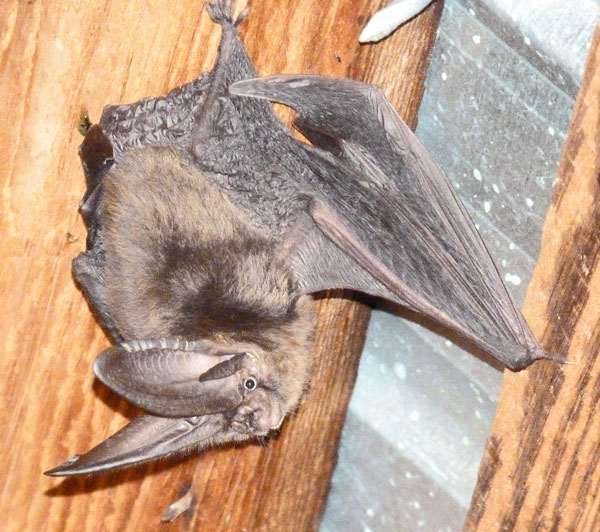
Habitat
Maternal colonies up to several hundred. In summer males roost alone.
Pups
One pup/year.
Food
Highly agile in flight. Able to glean insects off vegetation.
Range
Hibernates in caves in the BC, incl. Vancouver Island.Range: Canada – only in BC. USA – mostly in west, in east rare.
The little bats
California Bat
Mvotis californicus
One of the smallest BC bats.
Wingspan 21-25cm.
Small forearm 29-35mm. Wt 3.3-5.4g.
Fairly long ears, extend just beyond nose, long narrow tragus.**
Dull rusty to blackish brown fur.
(Similar species: Long-legged – but shorter forearm. Yuma & Little brown – but has keel on calcar).
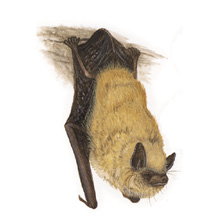
Habitat
Uses diverse habitats, has small maternal colonies, is flexible in choice of night roosts.
Pups
One pup/year.
Activity
May be active on southern coast in winter, often hibernates in buildings, occasionally emerges to forage.
Range
Western NA from southern Mexico to Alaska.
Long-legged Bat
Myotis volans
BC Blue-listed
Medium-sized “little’ bat.
Wingspan 22-27cm. Wt 6-10g. Forearm 34- 43 mm.
Ears smaller, barely reach nose.
Red-brown to nearly black fur. Fur on wings extends to knees & elbows.
(Similar species: California – but longer forearm. Big brown – but shorter forearm & has fur on wings).
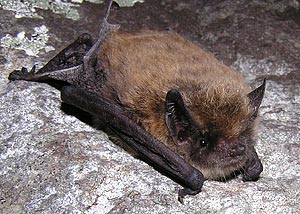
Habitat
Roosts under bark, in snags, tree & rock crevices & buildings. Uses maternal colonies.
Pups
One pup/year.
Food
Broad range of insect prey.
Range & Activity
Western NA, central Mexico to SW Alaska. Hibernates in mines & caves, also in northern range.
Little Brown Bat
Myotis lucifugus
Canada Endangered
Medium-sized “little’ bat.
Wingspan 22-27cm. Wt 6-10g.
Ear medium length, reach nostrils.
On coast, blackish fur, long, glossy. Lighter undersides. Dark brown ears & wings.
(Similar species: California & Long-legged – but lacks keel on calcar. Yuma – but often more aggressive when handled. Need DNA or acoustic calls to separate from Yuma).
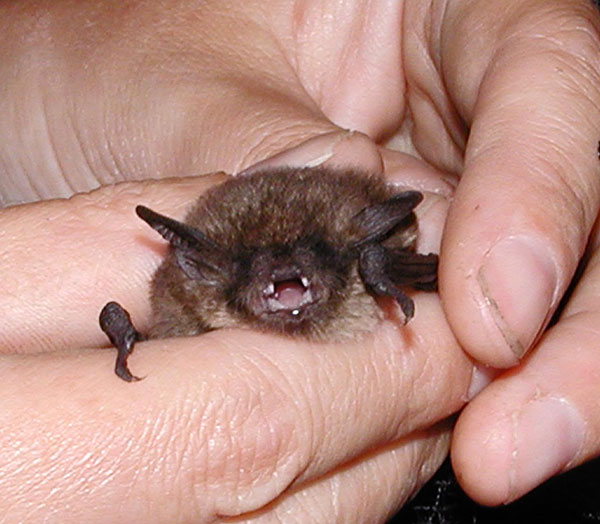
Habitat
Wide range of habitats. Summer often roosts in buildings, also under bark & tree & rock cavities. Females in large maternal colonies in hot (30-55ºC) sites.
Pups
One pup/year. v. rarely twins.
Diet
Broad variety of prey, diet varies with insect abundance, usually caught & eaten in flight.
Range & Activity
Hibernates Sept-Oct to April-early May in caves & mines that may be some distance from summer habitat. Formerly across NA, now populations being decimated by White Nose Syndrome in hibernacula.
Western Long-eared Bat
Myotis evotis
Canada Endangered
Large “little bat.
Wingspan 24-29cm. Wt 4-9g.
Ears long, extend 5mm or more beyond nose.
On coast fur usually dark brown nearly black.
(Similar species: Keen’s long-eared – Impossible to tell in field).
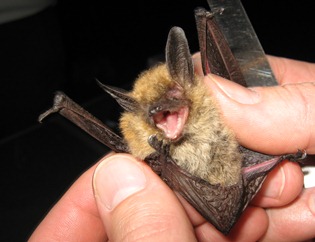
Habitat
Wide range of habitats, sea level up to 1220m on coast. Small maternal colonies usually in buildings, 5-30 bats & may have some males. Also roost under tree bark, in caves, mines, crevices in rocks & trees & may roost at ground level.
Pups
One pup/year.
Diet
Main prey – moths, also feeds on beetles, flies & spiders. Quiet, short-duration, high-pitched calls, good for hunting in heavy vegetation. Hunts in flight & gleans off vegetation & ground.
Range & Activity
Hibernates in mines & caves, few records. Western NA, from Bella Coola, BC to Baja.
Yuma Bat
Myotis yumanensis
Canada Endangered
Medium-sized “little’ bat.
Wingspan 21-26cm. Wt 4-9g.
Ears medium length, reach nostrils.
Back fur pale brown to almost black, paler under.
(Similar species: Long-legged & California – but no calcar keel. Little brown – Need DNA or acoustic calls to separate).

Habitat
Closely associated with water. Roosts usually buildings, also caves, tree & rock crevices. Maternal colonies may be large to 2000, Males alone or small groups.
Pups
One pup/year.
Diet
Feeds on aquatic insects, esp. midges.
Range & Activity
BC hibernacula unknown, caves used in Wa. Range low elevation in BC to 730m, from western NA, Mexico to S. BC.
Rare bat species on Denman
Denman has large maternal colonies of two rare-listed species of bats.
Townsend’s Big-eared bat
Denman’s Townsend’s Big-eared maternal bat colony is still flourishing in 2017. This colony is one of the biggest known in BC. The Townsend’s bat is Blue-listed in BC. Being on the “Blue list” in BC refers to “List of ecological community, and indigenous species and subspecies that are of special concern (formerly vulnerable) in British Columbia.” http://www2.gov.bc.ca/gov/content/environment/plants-animals-ecosystems/conservation-data-centre/explore-cdc-data/glossary-for-species-ecosystems-at-risk

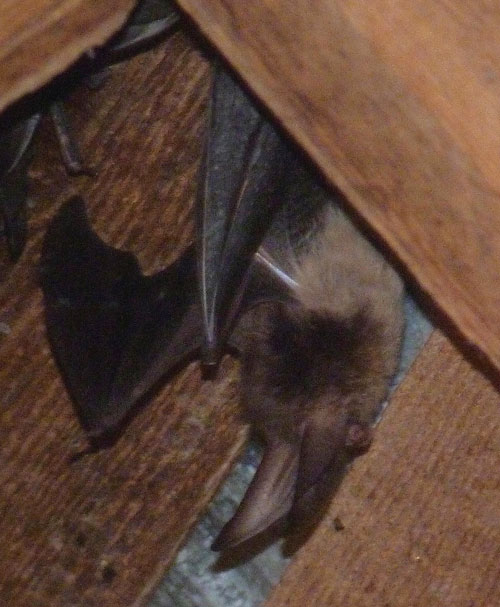
Elements are of special concern because of characteristics that make them particularly sensitive to human activities or natural events. Blue-listed elements are at risk, but are not Extirpated, Endangered or Threatened.
While the Townsend’s mums are busy raising their offspring in the maternal colony and hunting fields for bugs, the male Townsend’s may be foraging and resting all over Denman. The males will roost alone or in small groups in buildings or other sites. Learning the habitats for male Townsend’s is also important, so reporting single or multiple bat-roost sites provides valuable data. These roost site locations can be sent to di2017bats [at] gmail.com.
Little brown bat
Myotis lucifugus
Our other rare species is the Little Brown bat. This species is now on Canada’s Endangered species list due to White Nose Disease. An Endangered species is “a wildlife species that is facing imminent extirpation or extinction.” http://www2.gov.bc.ca/gov/content/environment/plants-animals-ecosystems/conservation-data-centre/explore-cdc-data/glossary-for-species-ecosystems-at-risk

While the Little Brown bat was still considered common in BC as of 2016, the White Nose Disease fungus Pseudogymnoascus destructanshas been killing off these bats all across North America. This disease spread across from the east and last year was found on a bat in Washington State. Both Big brown and Little brown bats are at risk.
We are hoping that by providing enhanced bat-habitat, becoming bat-knowledgeable and by counting our bats, we will retain this valuable species or at least know that they have been affected. We will be repeating the guano genetics at the Old School house, as well as Anabat acoustic (bat echolocation call) identification around the island this summer to track various bat species, particularly our Little brown bats.

